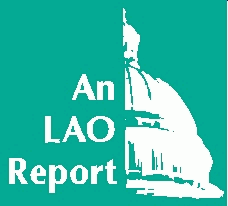
 |
LAO Recommended Legislation |
Require the department to contract for an evaluation of the cost-effectiveness of giving counties the discretion to reduce required weekly hours of participation from 32 hours to 20 hours for families with a child under age six.
Federal law requires that single-parent families with children under age six participate in work-related activities for a minimum of 20 hours per week. Beginning in 1999, current state law sets the minimum participation requirement at 32 hours for all single parent families. Given the high cost of child care for preschool children, providing county case managers with the flexibility to set participation standards for families with young children between the federal minimum (20 hours per week) and the California Work Opportunity and Responsibility to Kids (CalWORKs) program minimum (32 hours per week) could facilitate cost-effective use of CalWORKs resources. (We note that subsequent to publication of our report, nine counties have indicated an interest in participating in such an evaluation.)
Please see our January 1998 report, CalWORKs Welfare Reform: Major Provisions and Issues, page 20.
Todd Bland: 445-6061
Require the state to assume administrative control of the program.
Additional spending in the program is likely to lead to additional savings to the state through greater recoupment of California Work Opportunity and Responsibility to Kids (CalWORKs) grant costs. The existing funding system gives counties control over the level of spending in the program, but does not give counties the incentive to spend at the level that is optimal from the state's perspective. State administration of the program would facilitate an optimal allocation of resources to maximize net revenues.
Please see our 1992-93 Perspectives and Issues, page 153.
Chuck Lieberman: 445-6061
Eliminate the "advance pay" option in the In-Home Supportive Services (IHSS) program.
There are approximately 940 cases in an average monthless than 1 percent of the total IHSS caseloadin which payments for services are sent to the recipient at the beginning of each month, before services are rendered. State law authorizes this method of payment for severely impaired recipients. These advance pay cases, however, are not eligible for federal funding. Elimination of the advance pay option would not reduce the level of services to recipients. It would require that all payments be made to the service provider on an arrears basis, which is how almost all IHSS cases are paid. Eliminating the advance pay option will save the state approximately $2 million annually.
Please see our 1995-96 Analysis, page C-147.
Chuck Lieberman: 445-6061
Require the use of regional nursing bed clearinghouses to facilitate the transfer of Medi-Cal patients needing only nursing care from hospitals to less costly freestanding nursing facilities.
Current law requires hospitals to individually contact nursing homes during regular workdays to seek placements for Medi-Cal patients who no longer require hospital care, but who do need nursing care. If an appropriate outside placement is not located, then the patient may remain in a hospital-based nursing bed.
The current process is cumbersome, imposes administrative costs on hospitals and the department, and is potentially subject to manipulation by hospitals that have a financial incentive to retain patients in their own nursing beds.
Regional clearinghouses would maintain a central database of available nursing beds that would simplify and expedite the placement process, reduce hospital administrative costs, and allow the department to easily verify compliance with the placement process. State savings could be up to several million dollars annually.
Please see our 1997-98 Analysis, page C-50.
Daniel Rabovsky: 445-6061
Require physician office laboratories (POLs) to have at least one licensed clinical laboratory technologist when conducting moderate- or high-complexity tests.
A 1997 study of the reliability of lab test results found that POLs using unlicensed personnel to conduct moderate- and high-complexity tests had a failure rate more than twice that of POLs using licensed laboratory technologists. This recommendation is consistent with current law that requires non-POL labs to use licensed technologists for all such tests.
Chuck Lieberman: 445-6061
Require qualifying participants in the California Children's Services (CCS) Program to enroll in the Healthy Families Program.
Currently, the state and the counties equally share the cost of providing eligible medical services to children in the CCS program who do not qualify for Medi-Cal. Enrollment in Healthy Families would provide these children with coverage for a broader range of services, including dental and vision care, and would result in state and county savings by shifting two-thirds of the cost to federal funds. Requiring enrollment in Healthy Families for qualifying CCS children (rather than relying on gradual voluntary enrollment) would maximize this coverage and fiscal benefits and result in annual net state and county savings on the order of $6 million each.
Please see our 1998-99 Analysis, page C-20.
Daniel Rabovsky: 445-6061